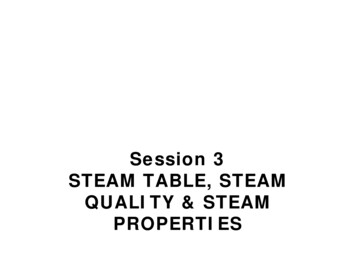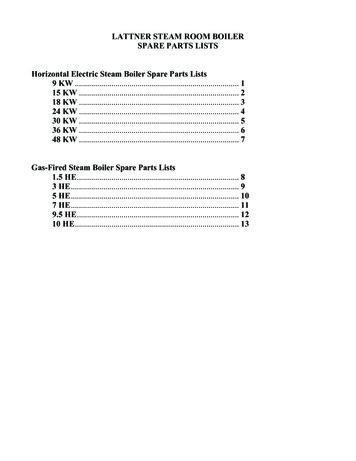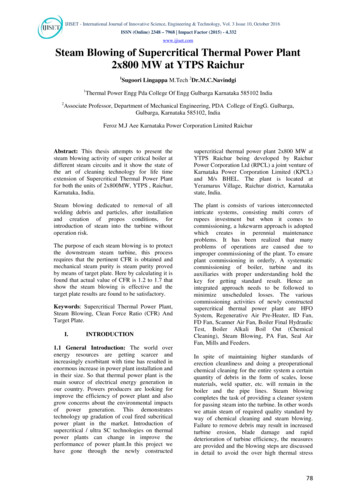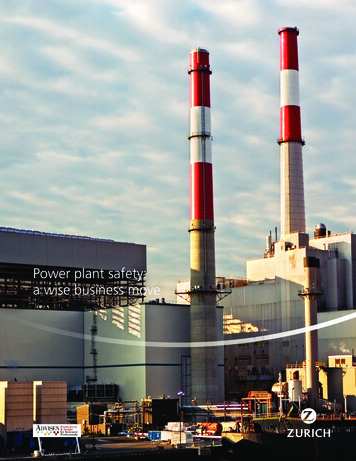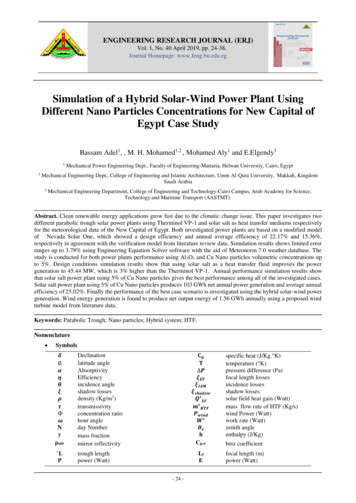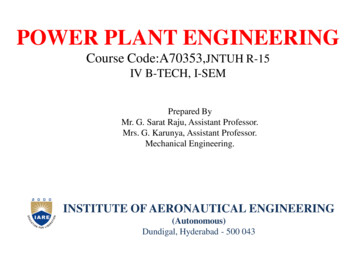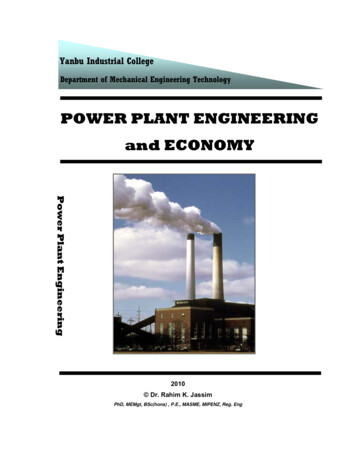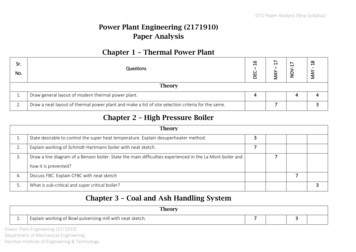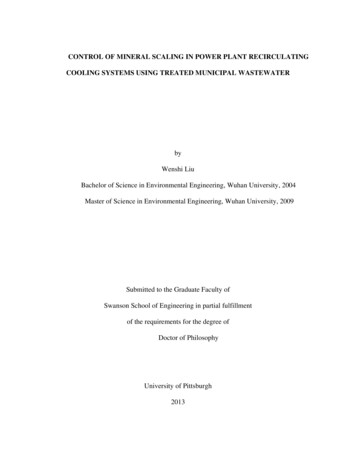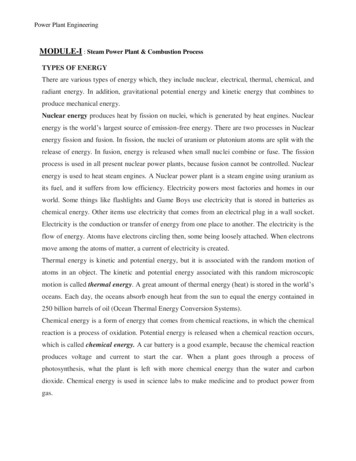
Transcription
Power Plant EngineeringMODULE-I : Steam Power Plant & Combustion ProcessTYPES OF ENERGYThere are various types of energy which, they include nuclear, electrical, thermal, chemical, andradiant energy. In addition, gravitational potential energy and kinetic energy that combines toproduce mechanical energy.Nuclear energy produces heat by fission on nuclei, which is generated by heat engines. Nuclearenergy is the world’s largest source of emission-free energy. There are two processes in Nuclearenergy fission and fusion. In fission, the nuclei of uranium or plutonium atoms are split with therelease of energy. In fusion, energy is released when small nuclei combine or fuse. The fissionprocess is used in all present nuclear power plants, because fusion cannot be controlled. Nuclearenergy is used to heat steam engines. A Nuclear power plant is a steam engine using uranium asits fuel, and it suffers from low efficiency. Electricity powers most factories and homes in ourworld. Some things like flashlights and Game Boys use electricity that is stored in batteries aschemical energy. Other items use electricity that comes from an electrical plug in a wall socket.Electricity is the conduction or transfer of energy from one place to another. The electricity is theflow of energy. Atoms have electrons circling then, some being loosely attached. When electronsmove among the atoms of matter, a current of electricity is created.Thermal energy is kinetic and potential energy, but it is associated with the random motion ofatoms in an object. The kinetic and potential energy associated with this random microscopicmotion is called thermal energy. A great amount of thermal energy (heat) is stored in the world’soceans. Each day, the oceans absorb enough heat from the sun to equal the energy contained in250 billion barrels of oil (Ocean Thermal Energy Conversion Systems).Chemical energy is a form of energy that comes from chemical reactions, in which the chemicalreaction is a process of oxidation. Potential energy is released when a chemical reaction occurs,which is called chemical energy. A car battery is a good example, because the chemical reactionproduces voltage and current to start the car. When a plant goes through a process ofphotosynthesis, what the plant is left with more chemical energy than the water and carbondioxide. Chemical energy is used in science labs to make medicine and to product power fromgas.
Power Plant EngineeringRadiant energy exists in a range of wavelengths that extends from radio waves that many bethousands of meters long to gamma rays with wavelengths as short as a million-millionth (10– 12)of a meter. Radiant energy is converted to chemical energy by the process of photosynthesis.The next two types of energy go hand and hand, gravitational potential energy and kineticenergy. The term energy is motivated by the fact that potential energy and kinetic energy aredifferent aspects of the same thing, mechanical energy. Potential energy exists whenever anobject which has mass has a position within a force field.The potential energy of an object in this case is given by the relation PE mgh, where PE isenergy in joules, m is the mass of the object, g is the gravitational acceleration, and h is theheight of the object goes.Kinetic energy is the energy of motion. An object in motion, whether it be vertical or horizontalmotion, has kinetic energy. There are different forms of kinetic energy vibrational, which is theenergy due to vibrational motion, rotational, which is the energy due to rotational motion, andtransnational, which is the energy due to motion from one location to the other. The equation forkinetic energy is ½ mv2, where m is the mass and v is the velocity. This equation shows that thekinetic energy of an object is directly proportional to the square of its speed.POWER DEVELOPMENT IN INDIAThe history of power development in India dates back to 1897 when a 200 kW hydro-station wasfirst commissioned at Darjeeling. The first steam station was set up in Calcutta in 1899. By theend of 1920, the total capacity was 130 mW, comprising. Hydro 74 mW, thermal 50 mW anddiesel 6 mW. In 1940, the total capacity goes to 1208 mW. There was very slow developmentduring 1935-1945 due to Second World War. The total generation capacity was 1710 mW by theend of 1951. The development really started only after 1951 with the launching of the first fiveyear plan.During the First Plan, construction of a number of Major River Valley Projects like BhakraNangal, Damodar Valley, Hira Kund and Chambal Valley was taken up. These projects resultedin the stepping up of power generation. At the end of the First Plan, generation capacity stood atlakh kW. Emphasis in Second Plan (1956-61) was on development of basic and heavyindustries and related need to step up power generation. Installed capacity at the end ofSecond Plan reached 57 lakh kw. Comprising 3800 mW thermal and 1900 MW hydel.During the Third Plan period (1961-66), emphasis was on extending power supply to rural areas.
Power Plant EngineeringA significant development in this phase was emergence of Inter-state Grid System. The countrywas divided into Five Regions to promote power development on a Regional Basis. A RegionalElectricity Board was established in each region to promote integrated operation of constituentpower system. Three Annual Plans that followed Third Plan aimed at consolidating programmesinitiated during the Third Plan.Fourth Plan envisaged need for central participation in expansion of power generationprogrammes at strategic locations to supplement activities in the State Sector. Progress duringthe period covering Third Plan, three Annual Plans and Fourth Plan was substantial withinstalled capacity rising to 313.07 lakh kW compression; 113.86 lakh kW from Hydro-electricProjects, 192.81 lakh kW from Thermal Power Projects and balance of 6.4 lakh kW fromNuclear Projects at the end of the Fifth Plan.During the Sixth Plan, total capacity addition of 196.66 lakh kW comprising Hydro 47.68 lakhkW, Thermal 142.08 lakh kW and Nuclear 6.90 lakh kW was planned. Achievement, however,has been 142.26 lakh kW (28.73 lakh kW Hydro, 108.98 lakh kW Thermal and 4.55 lakh kWNuclear) 72.3 per cent of the target.The Seventh Plan power programme envisaged aggregate generating capacity of 22,245 mW inutilities. This comprised 15,999 mW Thermal, 5,541 mW Hydro and 705 mW Nuclear of theanticipated 22,245 mW additional capacity. Central Sector Programme envisaged capacityaddition of 9,320 Mw (7,950 mW Thermal, 665 mW Hydro and 705 mW Nuclear) during thePlan Period. During the Seventh Plan, 21401.48 mW has been added comprising 17104.1 mWThermal 3,827.38 mW Hydro and 470 mW Nuclear. Year wise commissioning of Hydro,Thermal and Nuclear Capacity added during 1985-86 to 1989-90 is given in.The Working Group on Power set up particularly the Planning Commission in the context offormulation of power programme for the Eighth Plan has recommended a capacity additionprogramme of 38,369 mW for the Eighth Plan period, out of which it is expected that the CentralSector Projects would add a capacity of 17,402 mW. The programme for the first year of theEighth Plan (1990-91) envisages generation of additional capacity of 4,371.5 mW comprising1,022 mW Hydro, 3,114.5 mW Thermal and 235 mW Nuclear.The subject ‘Power’ appears in the Concurrent List of the Constitution and as such responsibilityof its development lies both with Central and state governments. At the Centre, Department ofPower under the Ministry of Energy is responsible for development of Electric Energy. Thedepartment is concerned with policy formulation, perspective planning, procuring of projects for
Power Plant Engineeringinvestmentdecisions,monitoring of projects, training and manpower development,administration and enactment of Legislation in regard to power generation, transmission anddistribution. The depart-ment is also responsible for administration of the Electricity (Supply)Act, 1948 and the Indian Electricity Act, 191() and undertakes all amendments thereto. TheElectricity (Supply) Act, 1948, forms basis of administrative structure of electricity industry. TheAct provides for setting up of a Central Electricity Authority (CEA) with responsibility, interalia, to develop a National Power Policy and coordinate activities of various agencies and StateElectricity Boards. The act was amended in 1976 to enlarge scope and function of CEA andenable of creation of companies for generation of electricity. The Central Electricity Authorityadvises Department of Power on technical, financial and economic matters. Construction andoperation of generation and transmission projects in the Central Sector are entrusted to CentralPower Corporations, namely, National Thermal Power Corpora-tion (NTPC), National HydroElectric Power Corporation (NHPC) and North-Eastern Electric Power Corporation (NEEPCU)under administrative control of the Department of Power. The Damodar Valley Corporation(DVC} constituted under the DVC Act, 1948 and the Bhitkra Beas, Management Board (BBMB)constituted under the Punjab Reorganization. Act, 1966, is also under administrative control ofthe Department of Power. In addition, the department administers Beas Construction Board(BCB) and National Projects Construction Corporation (NPCC), which are construction agenciesand training and research organisations, Central Power Research Institute (CPRI) and PowerEngineers Training Society (PETS). Programmes of rural electrification are within the purviewof Rural Electrification Corporation (REC) which is a financing agency. ‘‘There are two jointventure Power Corporations under the administrative control of the Department of Power,namely, Nathpa jhakri Power Corporation and Tehri Hydro Development Corporation which areresponsible for the execution of the Nathpa Jhakri Power Project and Projects of the Tehri HydroPower Complex respectively. In addition to this, Energy Manage-ment Centre, an autonomousbody, was established in collaboration with the European Economic Community, which isresponsible for training, research, and information exchange between energy professionals. It isalso responsible for conservation of energy programmes/activities in the Department of Power.Significant progress has been made in the expansion of transmission and distribution facilities inthe Country. Total length of transmission lines of 66 kV and above increased from 10,000 ckt(circuit) km in December 1950 to 2.02 lakh ckt Km in March, 1990. Highest transmissionvoltage in the Country at present is 400 kV and above 19800 ckt km of 400 kV lines had been
Power Plant Engineeringconstructed up to March, 1990 and about 18000 ckt km of these are in actual operation. Prior tothe Fourth Plan, Transmission Systems in the Country were developed more or less as statesystems, as generating stations were built primarily in the State Sector. When State TransmissionSystems had developed to a reasonable extent in the Third Plan, potentiality of inter-connectedoperation of individual state systems with other neighboring systems within the region (northern,western, southern, eastern and north-eastern) was thought of. Fairly well inter-connected systemsat voltage of 220 kV with progressive overlay of 400 kV are presently available in all regions ofthe Country except North-eastern Region. With creation of Two Generation Corporations,namely National Thermal Power Corporation and National Hydro-Electric Power Corporation in1975, the Centre had started playing an increasingly larger role in the development of gridsystems. The 400 kV transmission systems being constructed by these organisa-tions as part oftheir generation projects, along with 400 kV inter-state and inter-regional transmission lineswould form part of the National Power Grid. National Power Grid will promote integratedoperation and transfer of power from one system to another with ultimate objective of ensuringoptimum utilization of resources in the Country. India now has well integrated Regional PowerSystems and exchange of power is taking place regularly between a large numbers of statesystems, which greatly facilitates better utilization of existing capacity.ENERGY CONSUMPTION AND STANDARD OF LIVING The energy consumption of a nation can be broadly divided into the following areas:–Domestic sector (houses and offices including commercial buildings)–Transportation sector–Agriculture sector–Industry sectorPer capita energy consumption of a country is an index of the standard of living of thepeople of the country.
Power Plant Engineering
Power Plant EngineeringRESOURCES FOR POWER GENERATION Fuels Energy stored in water Nuclear energy Wind energy Solar energy Tidal energy Geothermal energy Thermoelectric power
Power Plant EngineeringPOWER PLANT: A power plant may be defined as a machine or assembly of equipment thatgenerates and delivers a flow of mechanical or electrical energy.CLASSIFICATION OF POWER PLANTSSTEAM POWER PLANT LAYOUT:
Power Plant EngineeringA steam power plant must have following equipments:1. A furnace to burn the fuel.2. Steam generator or boiler containing water. Heat generated in the furnace is utilized to convertwater in steam.3. Main power unit such as an engine or turbine to use the heat energy of steam and performwork.4. Piping system to convey steam and water.In addition to the above equipment the plant requires various auxiliaries and accessoriesdepending upon the availability of water, fuel and the service for which the plant is intended.A steam power plant using steam as working substance works basically on Rankine cycle.Fig. shows a schematic arrangement of equipment of a steam power station. Coal received incoal storage yard of power station is transferred in the furnace by coal handling unit. Heatproduced due to burning of coal is utilized in converting water contained in boiler drum intosteam at suitable pressu
Power Plant Engineering MODULE-I: Steam Power Plant & Combustion Process TYPES OF ENERGY There are various types of energy which, they include nuclear, electrical, thermal, chemical, and radiant energy. In addition, gravitational potential energy and kinetic energy that combines to produce mechanical energy. Nuclear energy produces heat by fission on nuclei, which is generated by heat

